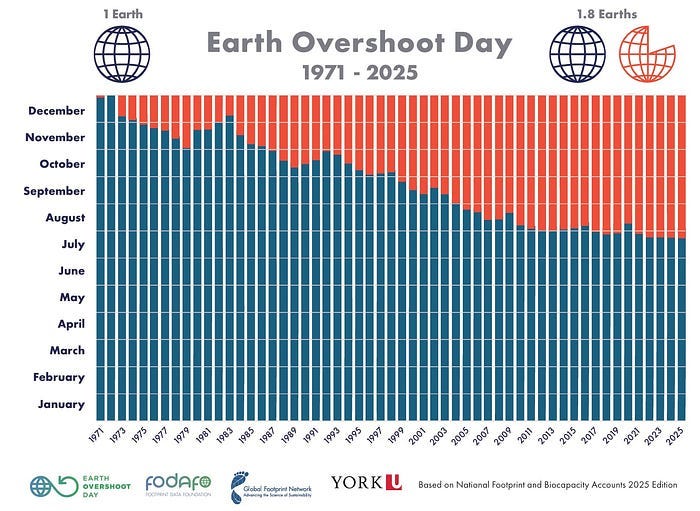Population Control: The End of the World or The Solution to Our Problems?
There’s only one reason for overshoot (and it’s not the one you might think)
The first sunburn of the year always feels like a mistake you should’ve seen coming. You stay on the beach a little too long, convinced your winter skin can take it, and by nightfall, you’re radiating heat like a broken stove. That’s overshoot: going beyond limits, not on purpose, but because you didn’t recognize where the line was until it burned you.
It happens everywhere, every day. You down too many espressos before an exam, and your hands shake uncontrollably. You crank the thermostat in mid-winter, only to sleep with the windows wide open hours later. You pile your plate at an all-you-can-eat buffet and realize halfway through the meal that your body has no intention of finishing what your appetite promised. We all overshoot, often enough that we’ve learned to deal with it — like when we test the water before stepping into the shower. Most of the time, the damage is trivial: a sunburn, a hangover, a bad night’s sleep.
Scale that pattern up to the entire planet, though, and the consequences may turn brutal.
Sustainable living requires staying within the regenerative capacity of the biosphere. In 1961, our collective footprint used 70% of Earth’s capacity. By the end of the 20th century, we had blown past 120%. Today, our species devours the equivalent of 1.8 Earths every year. One planet, drained at almost twice its rate of regeneration. We are the shrimp-red sunbather, the trembling caffeine addict, the party-goer having one too many drinks — except this time, there’s no morning after to recover.

Overshoot follows the same recipe at any scale: rapid change and growth, hard limits beyond which the system can’t safely go, and a dangerous delay in recognizing you’ve gone too far. These three are necessary and sufficient.
The change may be technological — an accelerating adoption beyond the available resources. It may be ecological — expansion of farmland into fragile ecosystems that cannot sustain intensive farming. It may be social — a continuously expanding network of connections and consumption that fragments attention and strains real relationships.
The limits are just as diverse — defined by carrying capacity, by regeneration rate, by thresholds of human adaptation, or other physical, biological, or psychological features of a system.
The delays, too, arise in many ways: ignored warning signs, outdated information, moving too slowly, getting tangled in red tape, or misunderstanding how things work. This delay is the killer. A body that doesn’t register that extra drink until it’s too late. Politicians that don’t act on carbon thresholds even decades after climate scientists have sounded the alarm. By then, momentum locks us into trajectories we can’t easily reverse.
Overshoot has only two exits: collapse or correction.
A crash when limits slam back. Or a deliberate, careful easing down. And right now, we’re still accelerating toward the wall, burning through more than one planet at a time.
And today, the forces shaping our minds, beliefs, and decisions — media, governments, corporations — want us to believe that the cure to humanity’s overshoot is something that’s been in the works for over half a century: that the world population stops growing, as if sheer numbers alone were the lever that could pull us back from collapse.
It isn’t.
Keep reading with a 7-day free trial
Subscribe to Antarctic Sapiens 🇦🇶 to keep reading this post and get 7 days of free access to the full post archives.



